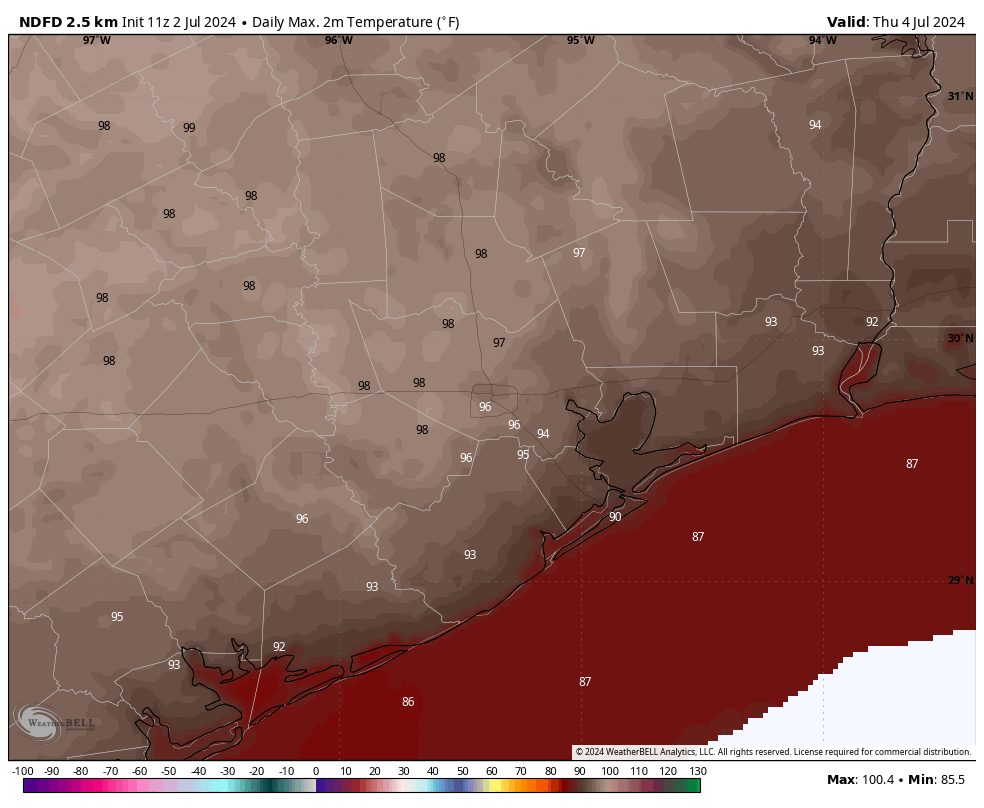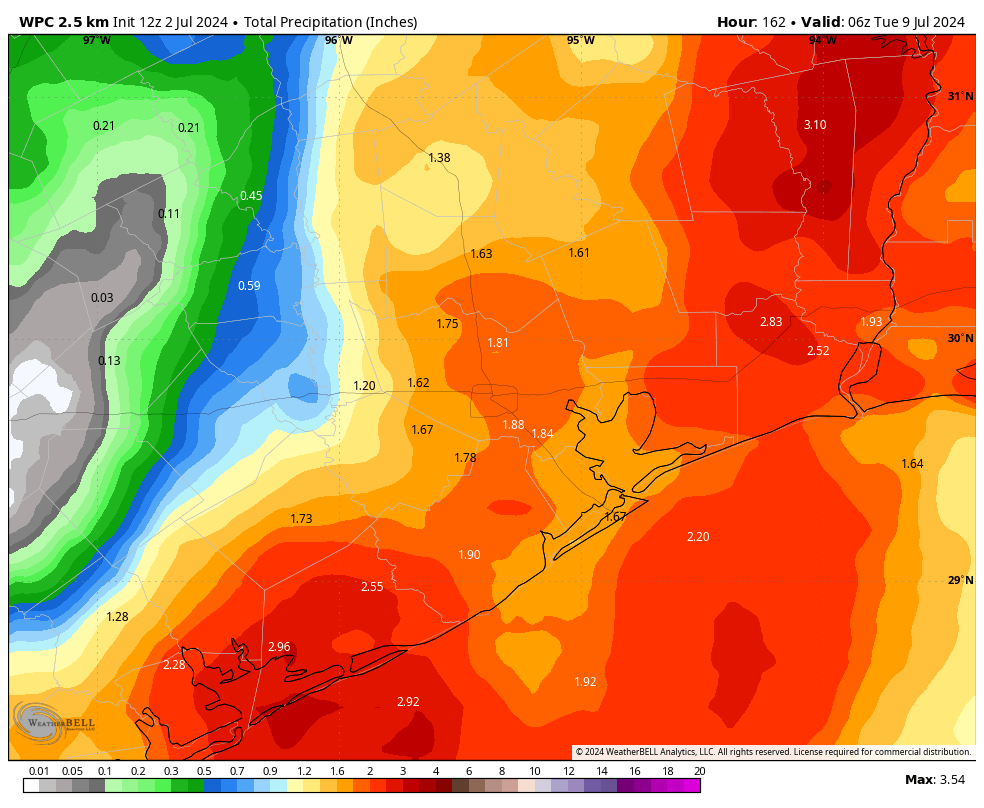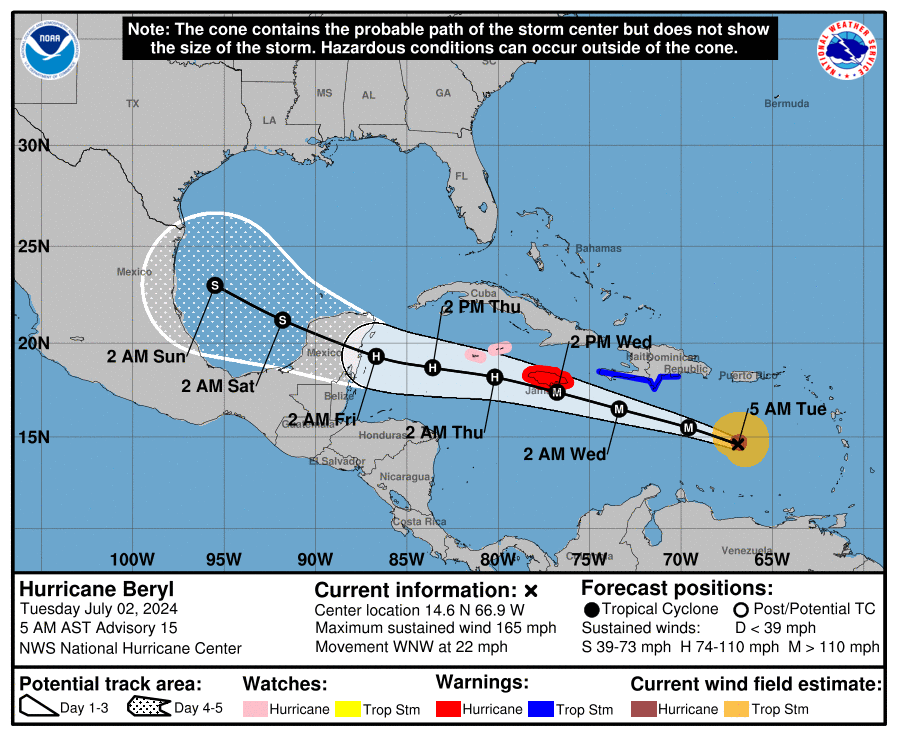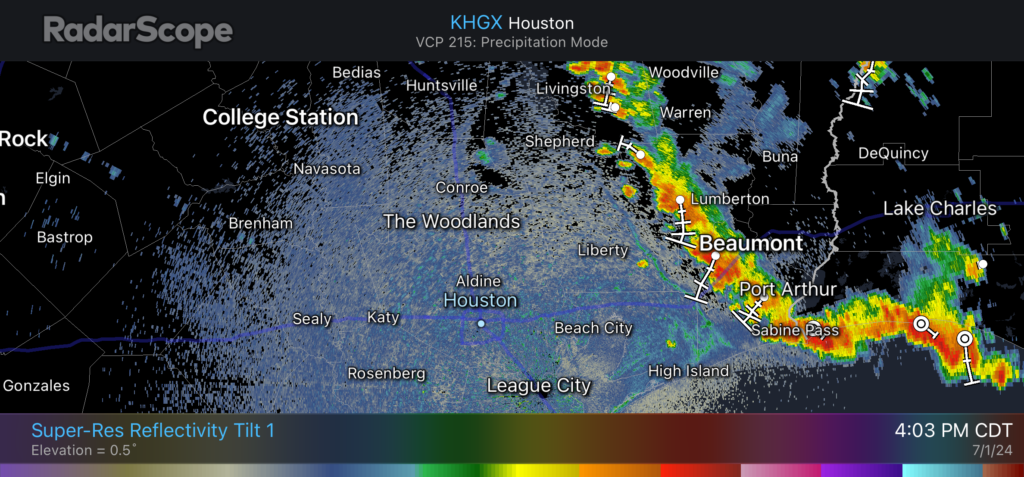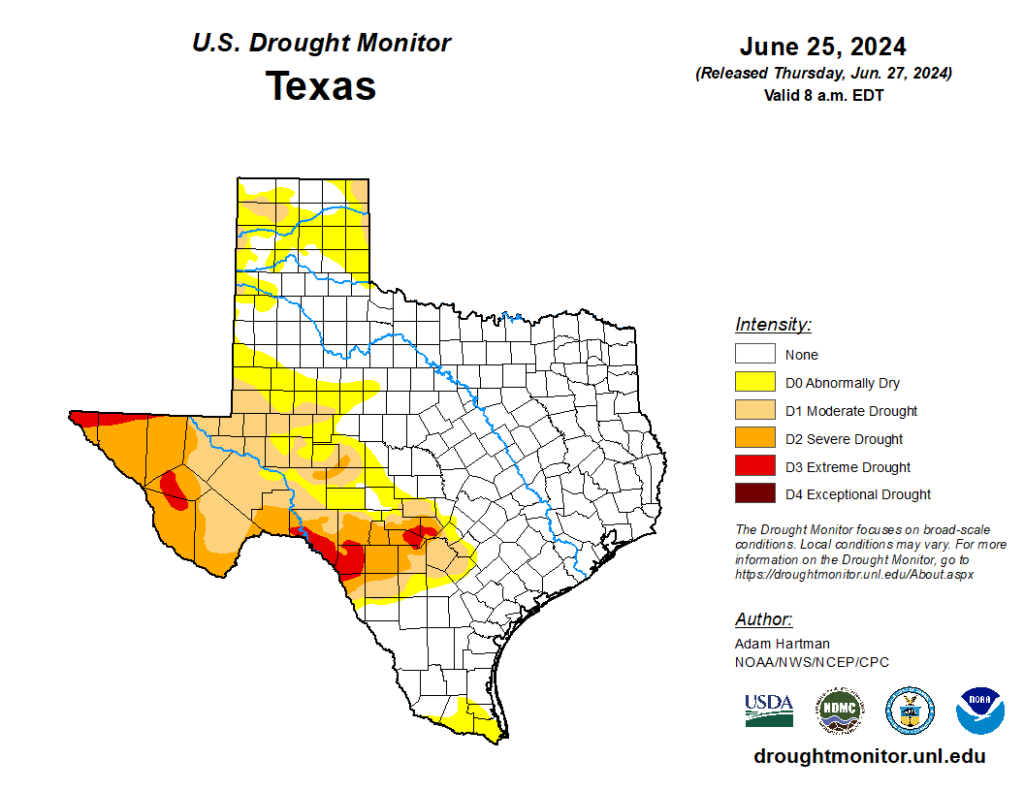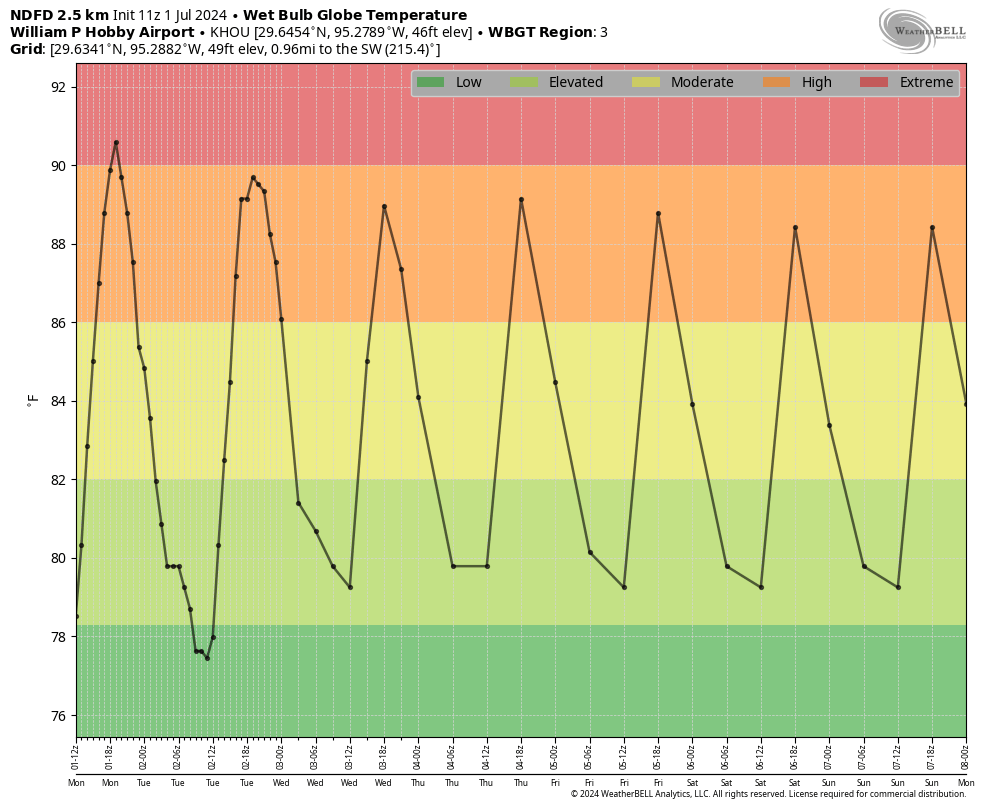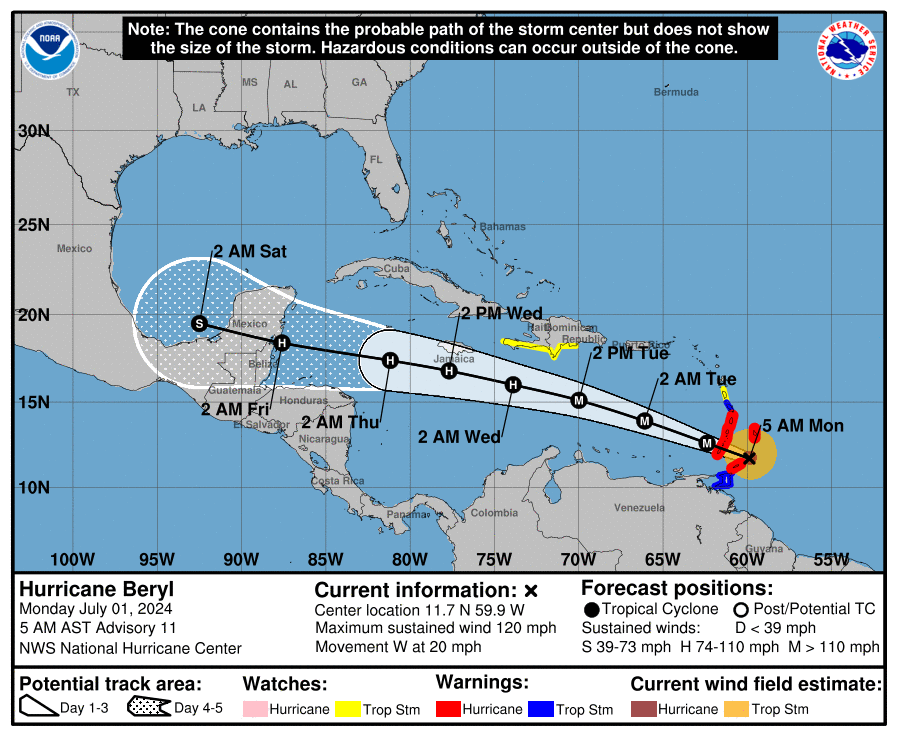In brief: Houston will be hot and sunny for the next couple of days, with only some scattered shower chances. The forecast begins to change this weekend, as Hurricane Beryl moves into the southern Gulf of Mexico. After that there are a lot of questions about what happens next, and this post attempts to address them as best we can.
Some thoughts on Beryl-mania
I want to start today’s post with some thoughts about Hurricane Beryl and hurricane season anxiety. In the last day or so Matt and I have been flooded with questions about this storm and its potential to impact the greater Houston area. Is the hurricane coming here? Will we flood? Are we going to see storm surge? How damaging will the winds be? There is just a ton of noise and chatter out there, and I want to say two things about it.
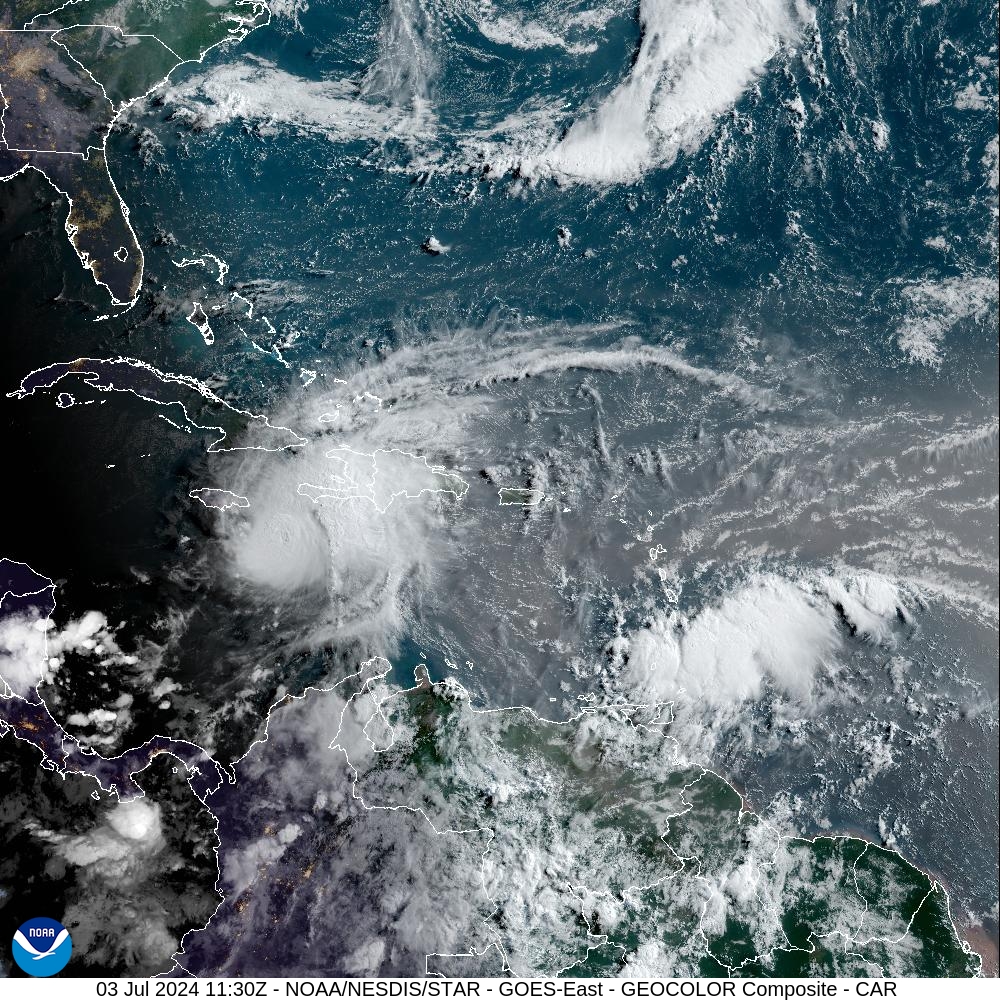
First, we don’t have the answers to a lot of the questions being asked. There are no absolutes in a five-, six-, or seven-day hurricane forecast. However, as I’ll discuss in the forecast below, it remains likely that significant wind and surge impacts from Beryl will go south of the Houston area. We’re most closely watching for increased rain chances next week. That doesn’t mean the forecast can’t change. But as we’ve been saying for a couple of days, in the big picture Beryl is likely to move inland into Mexico or South Texas, far from Houston. If our thinking changes on that, we’ll shout it from the rooftops.
Second, it’s going to be a long season, y’all. I get it. Beryl is a pretty ominous storm, because its intensity and rapid intensification are wholly abnormal for late June and early July. We’ve never seen this with a tropical system before, and it underscores the notion that this will be a hyperactive Atlantic hurricane season. However, the Texas coast has about three more months during which we are going to have to pay close attention to the tropics. Almost certainly there will be bigger threats than Beryl to Houston this summer, and times for great anxiety. This is not one of them.
Put simply, this is a marathon and not a sprint.
So please trust us when we say this: If you need to be concerned about a tropical system—like stocking-up-at-the-grocery-store or preparing-to-evacuate levels of concern—we are going to let you know as soon as possible. We just haven’t seen that signal yet from Beryl.
Wednesday
The story for the next couple of days will be one of heat as a high pressure ridge mostly holds sway. High temperatures will be in the mid- to to upper-90s through Friday or Saturday. Today we’ll see mostly sunny skies, with light southerly winds. There will be the usual smattering of afternoon and early evening shower chances along the sea breeze, but any showers that develop should be fairly scattered.
Thursday and Friday
These should be the hottest days of the upcoming forecast period, with highs in the upper 90s except for coastal areas, which will be a few degrees cooler. Skies will be mostly sunny with only perhaps a 10 or 20 percent chance of showers this afternoon. The only concern for fireworks on Thursday, the Fourth of July, will be temperatures which should still be sultry and in the upper 80s shortly after sunset.
Saturday, Sunday, and beyond
Rain chances will increase starting Saturday, and then persist through much of next week. From this point forward our weather will be guided by the track and evolution of Hurricane Beryl, and the potential for a trailing tropical system (Invest 96L) that may bring some additional moisture into Texas later next week. If I had to make a forecast for the weekend, I’d go with partly sunny skies and highs in the mid-90s on Saturday, with the potential for showers; and partly sunny skies on Sunday, highs in the low-90s, and perhaps a 50 percent chance of rain. I do think the better rain chances, and any potential for flooding, will hold off until at least Monday.
Hurricane Beryl
Beryl remains a very powerful hurricane this morning, with 145-mph sustained winds and a central pressure of 952 mb (which is rising, an indication of some slow weakening). It will pass near, or strike the southern edge of Jamaica today, exposing the entire Caribbean island to severe winds, heavy rains, and a large storm surge. This is a reasonable worst-case hurricane for the island, which will be subject to both coastal and inland flooding, in addition to major damage from winds.
Beryl is forecast to weaken as it crosses the Caribbean Sea later this week as it encounters some wind shear, before reaching the Yucatan Peninsula of Mexico on Thursday night or Friday morning. It is likely to be a Category 2 or Category 3 hurricane at this time, although there is some uncertainty in this. As it passes over land, Beryl should weaken further before entering the Gulf of Mexico later on Friday.
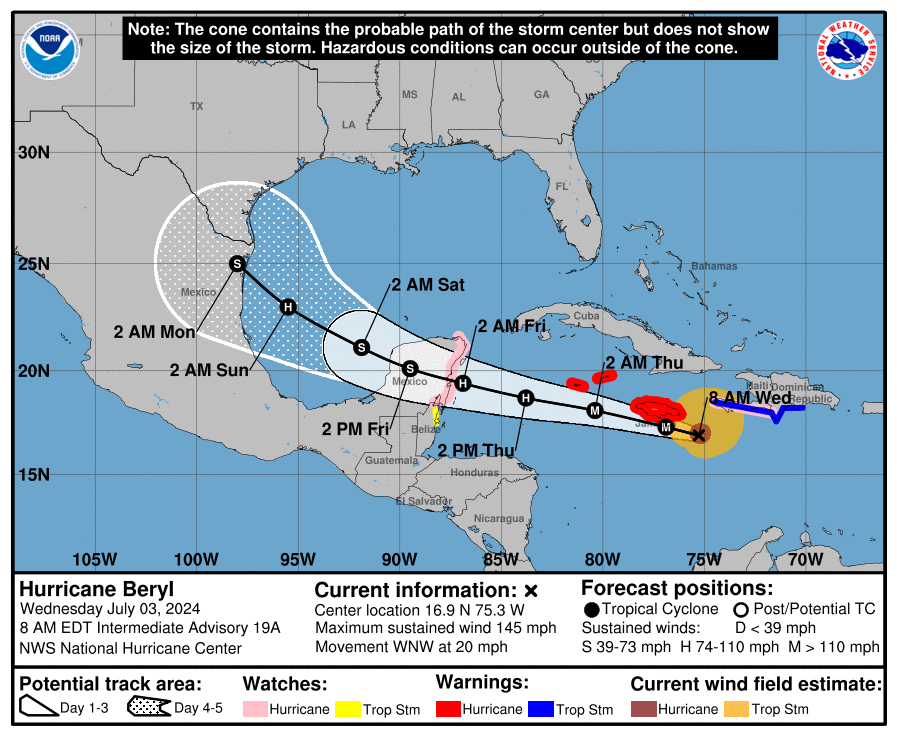
So what happens then? For Texas residents, that is it the big question. And there are a range of possibilities. Based upon my interpretation of the various hurricane models we could see everything from a tropical storm moving inland into the Mexico coast, near Tampico, on Sunday; to a Category 1 or Category 2 hurricane striking Corpus Christi on Monday. In the latter scenario, since Beryl would remain over water longer, it would have more time to re-strengthen over the Gulf of Mexico.
A majority of the hurricane focused models, including HAFS and HMON, favor the “tropical storm into Mexico” scenario, as does the European model and several other solutions. I’m sure a lot of social media attention will be paid to the GFS model this morning, as it brings a hurricane to the Texas coast between Brownsville and Corpus Christi early next week. But for the time being, this looks to be an outlier compared to most of our other guidance.
The official forecast from the National Hurricane Center, which is shown above and will be updated again at 10 am CT, shows a tropical storm/borderline Category 1 hurricane striking the Mexico coast about 50 miles south of Brownsville. I agree with their thinking.
Needless to say, for the upper Texas coast, there would be differing effects from these various scenarios. For Houston, I am not too concerned about winds—for now the worst I’d expect to see is some tropical storm force wind gusts on Sunday or Monday. Seas may get a few feet higher, like they did with Tropical Storm Alberto a couple of weeks ago. But again, for now, I’m not expecting a major storm surge event. The biggest and most widespread impact I expect to see is rainfall.
Beryl should bring some heavy rainfall to parts of Mexico and Texas starting on Sunday, and into next week. The issue is that as the storm crosses the Gulf of Mexico, the high pressure ridge to its north will start to break down, and its steering currents will weaken some. (This is the source of the uncertainty in its track over the Gulf). As a result Beryl may slow down some and have the opportunity to bring heavier rainfall over a couple of days. Please don’t misunderstand me, I am not saying this is another Hurricane Harvey.
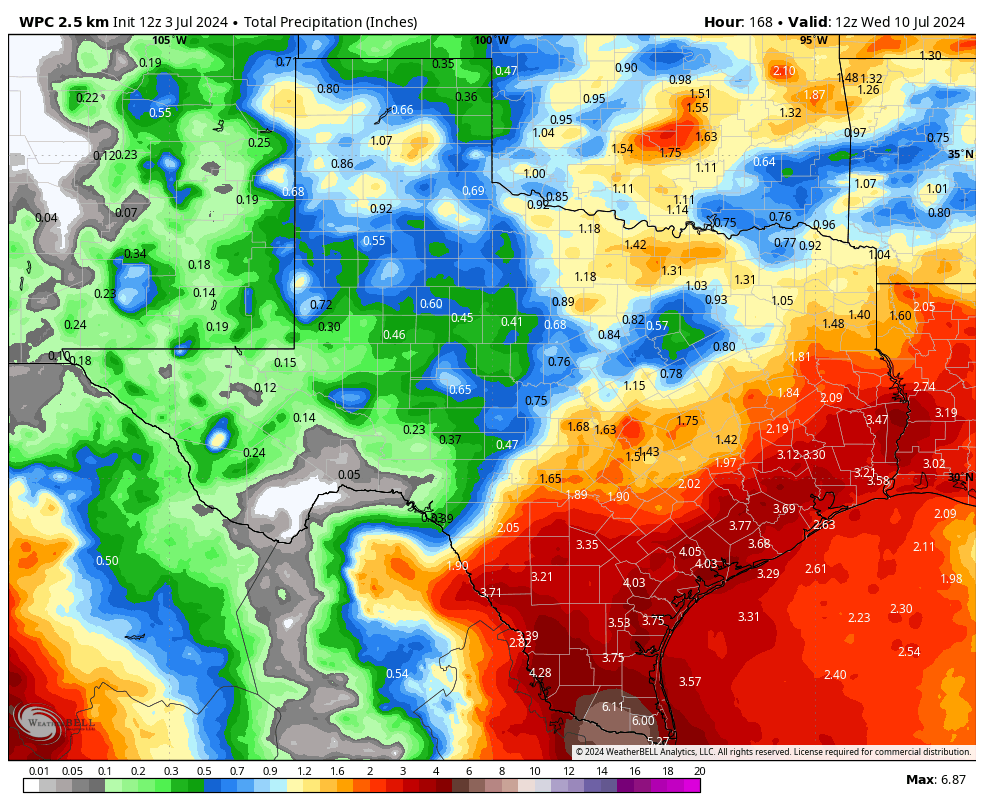
In any case, for Houston, the best chance of rainfall will likely come during the Monday through Wednesday period. My expectation right now is that most of the area receives a manageable 2 to 5 inches of rainfall. But there is some risk of higher totals. I consider this to be a lower probability, but given the influx of tropical moisture into the state of Texas next week we cannot rule out higher bullseyes and the potential for flooding.
I apologize for the lack of concrete answers, but so it goes in tropical forecasting. A good deal of uncertainty remains. At this time my sense is that Beryl goes far enough south to have modest effects on the upper Texas coast, besides increasing rain chances next week. But there remains some risk of more direct and serious effects. We’ll be watching this possibility closely and keep you updated with another post this afternoon. And for information about broader effects across Texas and Mexico, please visit our companion site The Eyewall.

